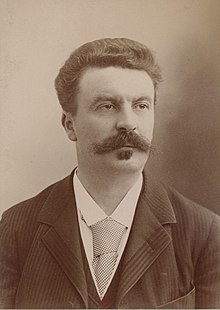Guy de Maupassant
| Guy de Maupassant | ||
 | ||
| Background information | ||
| Occupation: | Novelist, short story writer, poet | |
| Genre(s): | Naturalism, Realism | |
| Birthdate: | Aug 5, 1850 | |
| Born as: | Henri René Albert Guy de Maupassant | |
| Location: | Tourville-sur-Arques, French Second Republic | |
| Date of death: | Jul 6, 1893 - age 43 | |
| Death place: | Passy, Paris, French Third Republic | |
| Buried: | Montparnasse Cemetery, Paris | |
Henri René Albert Guy de Maupassant (✦5 August 1850 – †6 July 1893) was a French writer, remembered as a master of the short story form, and as a representative of the naturalist school of writers, who depicted human lives and destinies and social forces in disillusioned and often pessimistic terms.
Maupassant was a protégé of Flaubert and his stories are characterized by economy of style and efficient, effortless dénouements (outcomes). Many are set during the Franco-Prussian War of the 1870s, describing the futility of war and the innocent civilians who caught up in events beyond their control, are permanently changed by their experiences. He wrote some 300 short stories, six novels, three travel books, and one volume of verse. His first published story, "Boule de Suif" ("Ball of Fat", 1880), is often considered his masterpiece.
Significance
Maupassant is considered one of the fathers of the modern short story. He delighted in clever plotting and served as a model for Somerset Maugham and O. Henry in this respect. One of his famous short stories, "The Necklace", was imitated with a twist by both Maugham ("Mr Know-All", "A String of Beads") and Henry James ("Paste").
Taking his cue from Balzac, Maupassant wrote comfortably in both the high-realized and fantastic modes; stories and novels such as "L'Héritage" and Bel-Ami aim to recreate Third Republic France in a realistic way, whereas many of the short stories (notably "Le Horla" and "Qui sait?") describe apparently supernatural phenomena.
The supernatural in Maupassant, however, is often implicitly a symptom of the protagonists' troubled minds; Maupassant was fascinated by the burgeoning discipline of psychiatry and attended the public lectures of Jean-Martin Charcot between 1885 and 1886.
Legacy
Leo Tolstoy used Maupassant as the subject for one of his essays on art: The Works of Guy de Maupassant. His stories are only second to Shakespeare in their inspiration of movie adaptations with films ranging from Stagecoach, Citizen Kane, Oyuki the Virgin and Masculine Feminine.
Friedrich Nietzsche's autobiography mentions him in the following text:
- "I cannot at all conceive in which century of history one could haul together such inquisitive and at the same time delicate psychologists as one can in contemporary Paris: I can name as a sample – for their number is by no means small, ... or to pick out one of the stronger race, a genuine Latin to whom I am particularly attached, Guy de Maupassant."
Gene Roddenberry, in an early draft for the "The Questor Tapes", wrote a scene in which the android Questor employs Maupassant's theory that, "the human female will open her mind to a man to whom she has opened other channels of communications." In the script Questor copulates with a woman to obtain information that she is reluctant to impart. Due to complaints from NBC executives, this part of the script was never filmed.
Michel Drach directed and co-wrote a 1982 French biographical film: Guy de Maupassant. Claude Brasseur stars as the titular character.
- More information is available at [ Wikipedia:Guy_de_Maupassant ]
Chat rooms • What links here • Copyright info • Contact information • Category:Root